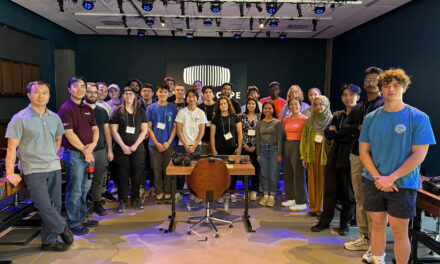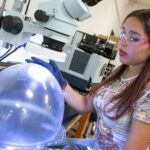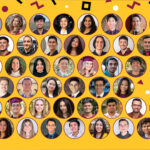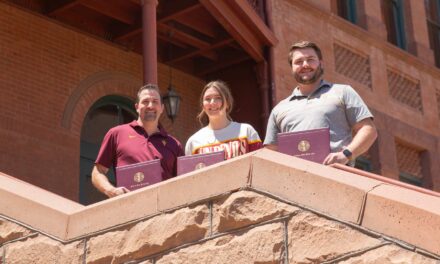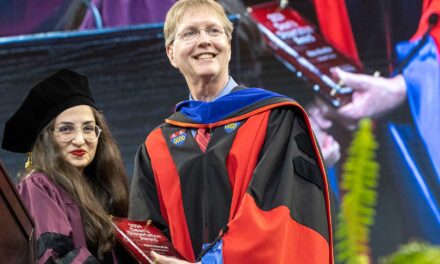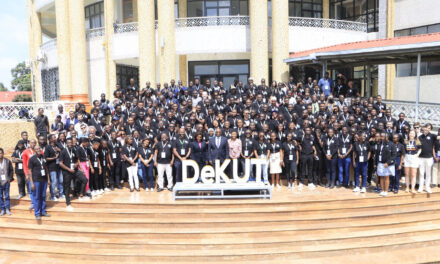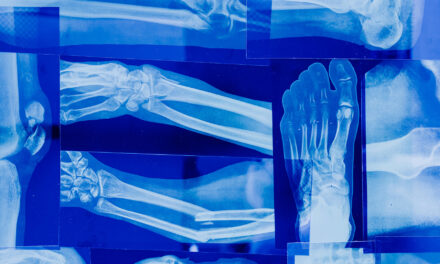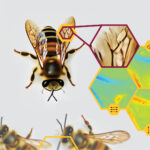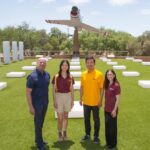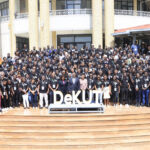
Hoolest lends an ear to stress relief
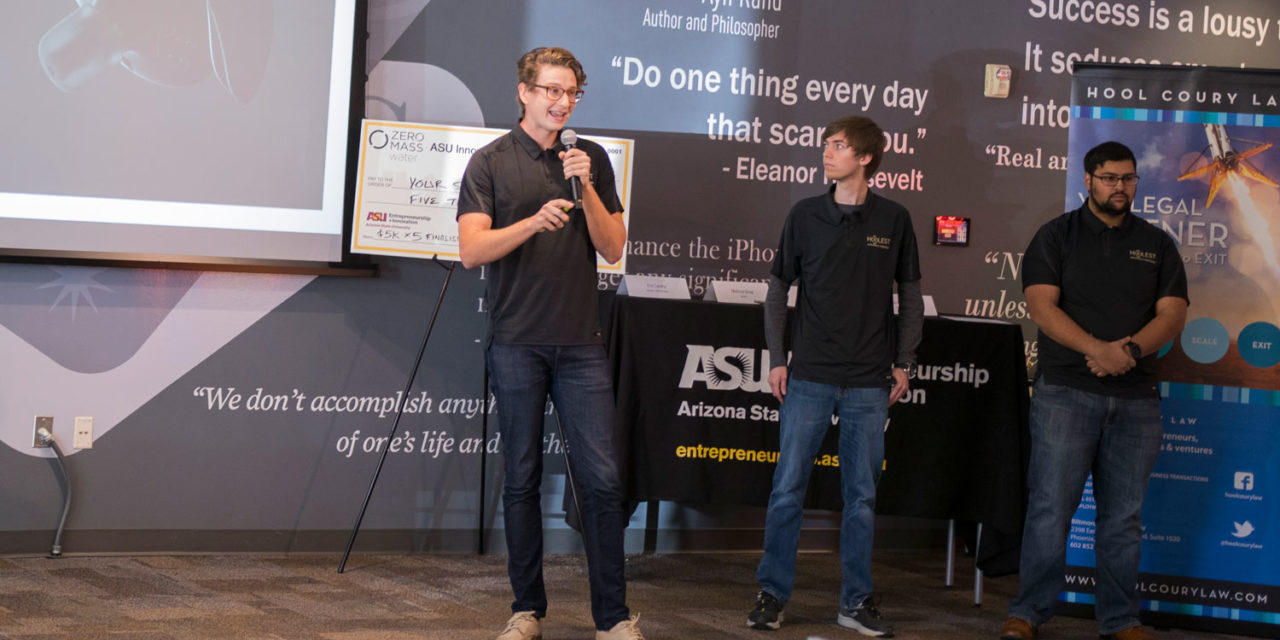
Above: Biomedical engineering graduate student Nicholas Hool, electrical engineering undergraduate student John Patterson and computer engineering graduate student Sami Mian from Arizona State University’s Ira A. Fulton Schools of Engineering pitch the Hoolest earbud at the ASU Innovation Open semifinal round. Photographer: Marco-Alexis Chaira/ASU
ASU student startup stays calm under pressure with anxiety management technology
Everyone gets nervous or anxious about something. You know the feeling. Your heart starts pounding, your body tenses up, maybe you start sweating and you feel like you can’t get through that speech or interview or match.
For Nicholas Hool, high-level sports in high school were a big source of anxiety. As a competitive golfer traveling the country for national tournaments, he often experienced performance anxiety before matches.
“Nerves are part of any sport, and generally a good thing, but when you can’t control your nerves it starts affecting your performance,” Hool said. “It’s not that I forgot how to play golf, it was a mental thing.”
Psychology coaches helped him relax through visualization and meditation, but Hool was more interested in the physical side of stress.
“I was interested in what is physically going inside your brain when you’re in that peak performance state versus when you’re extremely stressed, and what that difference is,” Hool said.
Hool, now a biomedical engineering graduate student in Arizona State University’s Ira A. Fulton Schools of Engineering, is creating an easy way to physically calm people’s nerves with his startup, Hoolest Performance Technologies.
In his graduate studies, Hool is working with William “Jamie” Tyler, an associate professor in the Fulton Schools and neural engineering expert, to study vagus nerve stimulation in an effort to create a device that reduces the effects of performance anxiety, stress and nervousness.
The vagus nerve is part of the peripheral nervous system and controls the body’s natural relaxation response — the parasympathetic response — and is the opposite of the body’s fight or flight response. When the vagus nerve is stimulated, the parasympathetic response activates and causes your whole body to slow down. Heart rate and blood pressure drop and even muscle tension subsides.
Part of the vagus nerve loop throughout your body runs up your neck, past your ears and into the brain. Scientific studies have shown that inserting an electrode into the ear — just like an earbud is used when listening to music — and running electrical current through it can activate the vagus nerve and cause that relaxation response.
Unlike drugs used for anxiety, vagus nerve stimulation uses the body’s own relaxation response and poses little risk. The electric current can be uncomfortable on the skin, but otherwise Hool said studies show it’s not dangerous to your heart unless you have an underlying heart condition, and doesn’t cause additional symptoms if you’re already relaxed.
“My first year in grad school I put in all the legwork in doing the research to determine if this was feasible,” Hool said. “Once I figured out that this earbud technology was possible, I set out to find a team that had the talent and capabilities to produce this device.”
Hool founded Hoolest with computer engineering graduate student Sami Mian and electrical engineering undergraduate student John Patterson in May 2017. Hool says having “rock star” ASU engineers like Flinn Scholars Mian and Patterson helping him create the device have proven to potential investors that they can make this idea work.
The team is working to create an affordable, easy-to-use device modeled after regular music earbuds.
“Because the electrode we’re using is the same size and shape as a regular earbud it’s super easy to design something that looks like a standard pair of headphone earbuds and, ultimately for us, it’ll be a lot cheaper to manufacture,” Hool said.
The design has an added advantage of already being familiar to users as well as discrete, so there’s no awkwardness to using them in public.
When used for 10 minutes, users can experience a relaxing effect that lasts 30 minutes to an hour.
Similar earbud technology has been around for the last 10 years or so, but existing earbuds on the market today are extremely irritating, Hool said. They are either made of metal, which can deliver a painful shock to the ear, or a softer material that has to be soaked in a saline solution before being placed in the ear. Hool claims his new electrode design will be the most comfortable earbud on the market and will allow millions more people to experience the benefits of the technology.
In Fall 2017 the Hoolest team entered into the ASU Innovation Open. The $100,000 prize was an attractive funding source to allow them to manufacture a small batch for a private beta run of testing. By the December 2017 semifinal round, Hoolest had prototypes of the device they had been testing themselves.
Hool was nervous before the team’s five-minute semifinal round pitch, and used a Hoolest earbud prototype for 10 minutes prior to their turn pitching to the judges.
“When I was walking into the building my heart was pounding. I used it for 10 minutes and once I started talking I felt great,” Hool said, adding that it worked so well when they were finished he was so relaxed he could have fallen asleep.
They ended up earning $10,000 from that semifinalist round. On February 2, Hoolest will compete in the final round against five other teams for the $100,000 prize. Hool plans to use the device again — just at a lower setting.
Hool believes his startup has been successful so far because of the size of the market and the social impact it could have.
“Every single person in that room could relate to the problem we’re solving,” Hool said. “300 million people in America are familiar with stress and anxiety and would pay to overcome it. That’s the number one reason we got through to the final round.”
Next, Hoolest hopes to progress from their handmade prototypes to working with Avnet to develop the final product and work with a local manufacturer to create a small batch. With a larger supply of Hoolest earbuds they hope to start a private beta test with elite athletes, and then launch a Kickstarter campaign to open it up to the entire world.
He also hopes to conduct additional studies on standard anxiety and cognitive enhancement, as well as how it affects opioid withdrawal symptoms.
“Initially we will market the product for athletes as a consumer product, but in the near-future we want to expand into medical markets with high demand, such as opioid addiction treatment,” Hool said. “There are some positive results and studies on how vagus nerve stimulation reduces withdrawals for drug rehabilitation.”

Hoolest Performance Technology’s Nicholas Hool (fourth from left) holds up the championship belt after his team won 1st place and $100,000 at the 2018 ASU Innovation Open finals on February 2. Photographer: Marco-Alexis Chaira/ASU
Read more about Hoolest’s pitch and win at the 2018 ASU Innovation Open.
2018 ASU Innovation Open Results
1st place and $100,000 prize: Hoolest Performance Technology, ASU
2nd place and $25,000 prize: Bloomer Health Tech, MIT
3rd place and $20,000 prize: AirGarage, ASU
Details: winasu.io.
Keep moving and don’t give up
The first tip to being a successful entrepreneur, Nicholas Hool said, is not giving up.
“Always apply for things and if you get shut down — which you likely will at the beginning — don’t take it personally,” said Hool, a biomedical engineering graduate student in Arizona State University’s Ira A. Fulton Schools of Engineering.
Hool has participated in the eSeed Competition, the ASU Innovation Open and Venture Devils to hone his entrepreneurial skills and to try to put his ideas into action. Along the way he’s been rejected but also had successes, with eSeed funding and the semifinalist ASU Innovation Open funding — with a chance at $100,000 coming up on the February 2 final round of the ASU Innovation Open.
At the graduate level, Hool credits the New Venture Challenge and instructor Scott Wald, president and chief executive officer of Romar Services, with setting him on the right path to be a successful entrepreneur.
“He takes 15-20 grad students trying to start a company and teaches them all there’s to know about running a business,” Hool said. “I learned so much in his class.”
Hool earned $25,000 in his final New Venture Challenge pitch for Hoolest. He was able to convince potential investors that his idea was possible to create with the help of his teammates, computer engineering graduate student Sami Mian and electrical engineering undergraduate student John Patterson.
He also recommends that anyone with an idea should just do something with it.
“Don’t just sit and think about the idea, do something about it,” Hool said. “Once you do something that gets someone to say ‘dang, that’s really cool,’ eventually more people will see you’re a hard worker and other hard workers will want to work with you and in a year you’ll have something that you can’t even stop, it’s going to go no matter what.”






